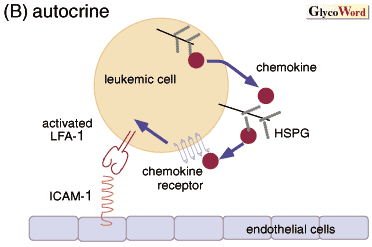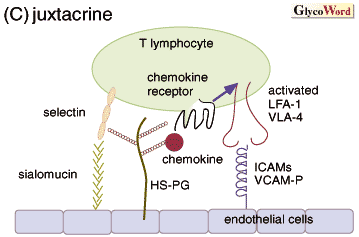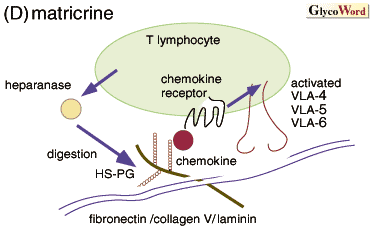| Heparan Sulfate Proteoglycan in the Context of Cytokines and Adhesion Molecules | |
| (Update Issue: April.17, 2007) | |
|
 | The conventional concept is that cytokines in solution act as diffusible factors. However, recent progress in cytokine research suggests that many cytokines and growth factors can function in a non-diffusible fashion when immobilized on either the cell surface or extracellular matrix (ECM) by binding to heparan sulfate proteoglycan (HS-PG). The number of cytokines that contain heparin-binding domains and can thus potentially be immobilized on HS-PG is wide and includes all the chemokines such as MIP-1 and IL-8 as well as IL-3, IL-7, IFN-gamma, GM-CSF, FGF and HGF. The ability of certain cytokines to bind to and be immobilized by HS-PG accentuates their action by: 1) promoting the accumulation of cytokines at high concentrations in the appropriate location to encounter their target cells; 2) activating cytokines by inducing conformational changes in the bound cytokine; 3) promoting conformation-dependent association or polymerization of cytokines and their receptors and facilitating the assembly of the appropriate molecular complex to initiate signal transduction; 4) protecting cytokines from both chemical and physiologic degradation.
In general, cytokines are produced by one cell and bind to their signaling receptors on another responding cell, thereby mediating cell-cell communication in a “paracrine” fashion. The most prominent example of the involvement of HS-PG in a paracrine model of cytokine functions is the FGF and its receptor systems. A dual receptor model has been proposed, in which binding of FGF to low affinity cell surface HS-PG receptors is required for the presentation of FGF to its high affinity signaling receptors, which in turn transmit and facilitate signals across the plasma membrane of the same cells (Fig. 1). | |
|
 |
|
 |
 |
|
 |
|
Fig. 1 Cytokines and adhesion molecules in the context with HS-PG.
HS-PG plays a central role in promoting multicrine regulatory mechanisms of cytokine functions including their ability to interact with cells in paracrine, autocrine, juxtacrine and matricrine interactions. |
|
|
| However, some cells, particularly but not exclusively tumor cells, produce cytokines which activate receptors on the same cell and thereby stimulate themselves in an “autocrine” manner. We suggest that this paradigm is particularly relevant to the autocrine stimulation of adhesion of circulating leukemic cells including adult T cell leukemia (ATL) cells to endothelial cells during their extravasation. HS-PG on ATL cells immobilizes the integrin-triggering chemokines MIP-1s allowing them to play a pivotal role in the continuous, autocrine triggering of integrins on the circulating leukemic cells. MIP-1 produced by ATL cells and posted on the cell surface HS-PG, preventing them from the dilution by the blood flow can be relayed to the signaling receptor in an autocrine mechanism. This implies a constant state of enhanced adhesion which facilitates ATL cell adhesion to endothelial cells, resulting in the severe infiltration into tissue.
Other cytokine interactions involve cytokines anchored in the membrane of the producer cell, which promote a close, often adhesion-dependent, interaction with the responder cell in a process termed “juxtacrine” secretion. The recruitment of leukocytes into tissues is regulated by a sequence of interactions between the leukocyte and the endothelial cells which start with selectin-mediated transient interaction, termed tethering, and are subsequently stabilized by integrin-mediated adhesion. HS-PG- bound chemokines, such as MIP-1 and IL-8, play a crucial role in this process by activating integrin-mediated firm adhesion of the tethered leukocytes to the luminal surface of endothelium in a juxtacrine fashion. This model overcomes the problem of "free" chemokines, which, if secreted into the circulation, would be washed away by the blood flow. We have proposed that chemokines are retained on the vessel wall by immobilization on HS-PG expressed on the luminal surface of endothelium at sites of inflammation. This model results in effective presentation of chemokines to circulating leukocytes, thereby promoting the triggering of adhesion and transendothelial migration. HS-PG in the ECM potentiates the “matricrine” stimulation of cells within the ECM by binding and presenting cytokines in association with ECM ligands.
Taken together, HS-PG plays a central role in promoting multicrine regulatory mechanisms of cytokine functions including their ability to interact with cells in paracrine, autocrine, juxtacrine and matricrine interactions. The ability of HS-PG to interact in so many ways with cytokines provides a further level of sophistication to cell-cell and cell-cytokine interactions. Furthermore, these interactions promote the assembly of the appropriate molecular complex to initiate signal transduction. The proposed model brings enormous power not only to the process of leukemic cell infiltration and tumor metastasis but also to the regulation of inflammation and leukocyte trafficking. | |
|
| Yoshiya Tanaka (The First Department of Internal Medicine, School of Medicine,
University of Occupational and Environmental Health, Japan) | |
|
|
| References | (1) | Tanaka Y, Kimata K, Adams DH, Eto S: Modulation of cytokine function by heparan sulfate proteoglycans: sophisticated models for the regulation of cellular responses to cytokines. Proc. Assoc. Am. Physicians 110, 118-125, 1998 |
| (2) | Tanaka Y, Kimata K, Wake A, Mine S, Morimoto I, Yamakawa N, Habuchi H, Ashikari S, Yamamoto H, Sakurai K, Yoshida K, Suzuki S, Eto S: Heparan sulfate proteoglycan on leukemic cells is primarily involved in integrin-triggering and its mediated adhesion to endothelial cells. J. Exp. Med. 184, 1987-1997, 1996 |
| (3) | Tanaka Y, Fujii K, Hubscher S, Aso M, Takazawa A, Saito K, Ota T, Eto S: Heparan sulfate proteoglycan on endothelium efficiently induces integrin-mediated T cell adhesion by immobilizing chemokines in rheumatoid synovitis. Arthritis Rheum. 41, 1365-1377, 1998 |
| | |
| |
| Dec.15, 2000 |
|
| |
|
|
|
|




